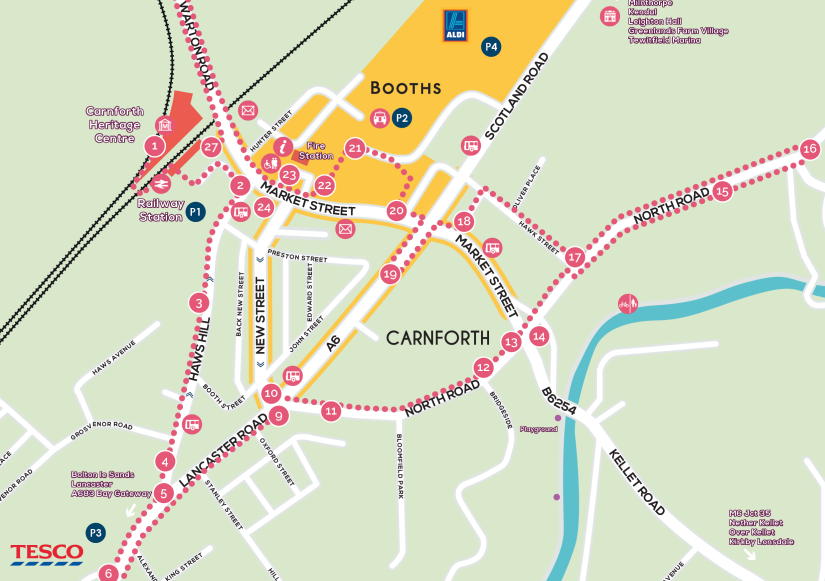Carnforth Heritage Trail - Self Guided Walking Trail

Start from Carnforth Heritage Visitor Centre at the railway station, where you will find information about the historical heritage of our town as well as the history of the local railways.
Leave the main station entrance, cross the car park and turn right into Haws Hill. The first building on your right is Station House, the former home of Station Masters. This shows the respect and position held by the Station Master in the 19th and early 20th Century.
The next building on your right, ‘The Haws’, was once a school for girls run by a Miss Pickford in the late 19th Century. It is now a private house.
Walk up Haws Hill to Lancaster Road. As you reach the top of Haws Hill there is an imposing building on your left - Kerneforde Hall. This was the former National School and was used until 1962.
Before the canal was built and the roads improved, this sloping junction was a significant feature of Carnforth. Travellers from the south had a choice of going down Haws Hill to Warton via the Keer Bridge or straight forward for 150 yards and into North Road. The present A6 to the traffic lights and beyond, did not exist.
Turn right and walk down the hill to the traffic lights by Tesco. The Tesco site and the Lodge Quarry Industrial Estate reminds us that stone quarrying and gravel extraction were major industries in the Town.
Looking further south, the long terrace that you see on the left beyond the petrol station is Bessemer Terrace, its name changed to Hall Street and was absorbed into Lancaster Road. The row of houses was moved, stone by stone, from the Iron Works site when steelmaking was introduced.
Cross the road, turn right, and then almost immediately left into the entrance area to the Lancaster Canal. Walk up to the canal basin where pleasure boats call into the ‘Canal Turn’ Public House. Some half a mile further south on the east side of the canal are the remains of the Carnforth Coke Ovens. Coal was brought along the canal from Wigan and turned into coke for domestic use. These ovens can be seen on a separate Canal Walk.
Return to Lancaster Road and turn right up the hill and past the former school. The flats on your right, known as Oxford Court, are on the site of the former Wesley Methodist Chapel.
Cross Lancaster Road by means of the Pelican Crossing and walk into New Street. The imposing building on your right is the former premises of the Carnforth Co-operative Society with a shoe shop, grocers, chemist and butchers. Upstairs was a grand hall which saw many local events including Friday evening dances and films.
Return to the road crossing and proceed into North Road which was once the main road to Scotland. No 10 North Road is the oldest house in Carnforth, built in 1688. Pass the Council Primary School and the Vicarage on your right. Next to the Vicarage is Plane Tree House, built in 1712.
On the left a little further down the road is the Civic Hall, a former drill hall for the 5th Battalion King’s Own Royal Regiment. The property supports a firing range underneath the main hall.
Then take a step back. The green at the junction of North Road and Kellet Road, in front of the Shovel Inn, is the old centre of the town. Before the canal was built the road/track from Warton to the Kellets passed behind the inn. The canal crossing required a new bridge at right angles to the canal and so a new road was built to traverse the other side of the Shovel Inn.
The Shovel Inn is one of the oldest inns in town dating from 1754. It was used as a stopping place for stage coaches from London to Glasgow and included holding cells for people the police had arrested.
Continue up North Road to number 101, the former home of Lord Cecil Parkinson of Carnforth, number 107 – Carnforth House - one of the best kept old houses in the Town.
A little further on the right is the old CofE Vicarage (116) and opposite is Birkett’s Farm, one of the oldest working farms in town. This remains a viable dairy farm with pasture on both sides of the road. An ancient pear tree is still growing in the grounds.
Return down North Road until you reach Hawk Street. As you walk down the street you will notice the views of the old Iron Works site and Warton Crag. Half way down the street is the Emmanuel Congregational Church, built in 1896.
There is a back street almost opposite the church. Walk down this and the Town Council Chamber is the building on your left as you emerge onto Market Street.
Cross Market Street and turn left up Lancaster Road. On your left is Christ Church and almost opposite is the old Police Station (1880). The name is still faintly legible in the stone work of the building. A crest is seen in the area above the door.
Return to the traffic lights and cross over lower Market Street. Almost immediately turn right down the left-hand side of a small shop towards the car park of the supermarket. Before entering the car park notice the old cobbled back street on your left. This is thought to be one of the oldest streets in the Town.
Booth’s car park occupies the site of the former Auction Mart, operational until the 1950’s. Walk to the left within the car park and you will see a plaque showing the site of the first Salvation Army Worship Centre within the town. This is on the wall of the Carnforth Clinic.
Continue to the left into Ash Trees Way. Turn right in front of the doctors’ surgery and into the War Memorial Gardens. Inscribed on the War Memorial are the names of those from Carnforth who lost their lives in the two World Wars and shortly afterwards as a result of their injuries. This memorial was erected in 1923 and was financed by donations from the residents of the town.
Adjacent to the gardens is the Fire Station, built in 1927 but still operational today by retained fire fighters. Next to the gardens was the old Roxy Cinema (1921-61), now a supermarket.
Across the road from this building is the Royal Station Hotel, currently being restored to its former glory.
Walk on into Warton Road past the old Crown Post Office, over the railway bridge and to the right is the site of the old Carnforth Iron Works. If you walk down this road for about 100 yards you will see the original entrance to the Iron Works. This entrance is bricked-up because of the dangerous access at this point.
Walk on to the junction with Shore Road on the left, where you will see the old horse trough used by the hoses pulling the slag to the shore tipping site.
Return up Warton Road to your starting point at the railway station. While you are here, why not take the opportunity to visit the Brief Encounter Refreshment Room Bistro or Carnforth Heritage Visitor Centre on the platform.
---------------------------------
Now enjoy this walk:
See the interactive map at the bottom of this page
















